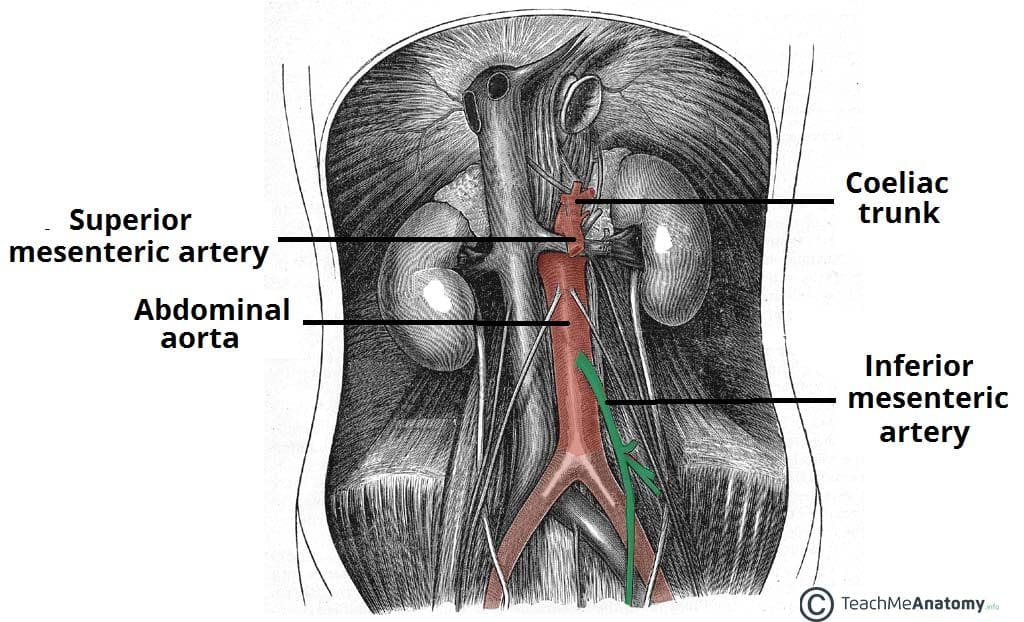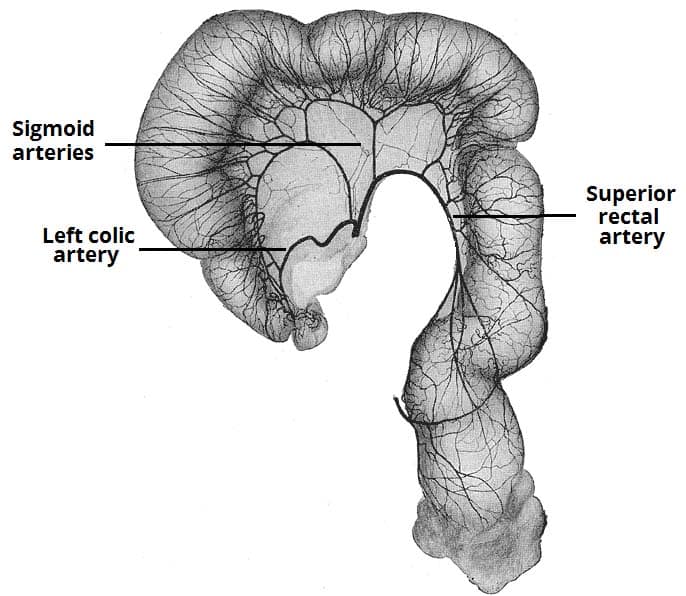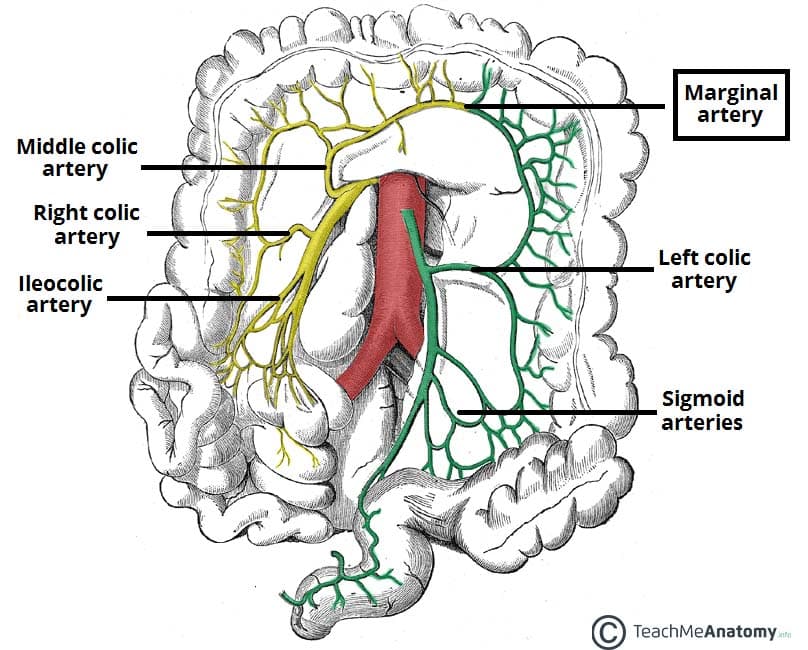The inferior mesenteric artery (IMA) is a major branch of the abdominal aorta. It supplies arterial blood to the organs of the hindgut – the distal 1/3 of the transverse colon, splenic flexure, descending colon, sigmoid colon and rectum.
In this article, we shall look at the anatomy of the inferior mesenteric artery – its anatomical position, major branches and clinical correlations.
Anatomical Position
The inferior mesenteric artery is the last of the three major anterior branches of the abdominal aorta (the other two are the coeliac trunk and superior mesenteric artery). It arises at L3, near the inferior border of the duodenum, 3-4 cm above where the aorta bifurcates into the common iliac arteries.
As the artery arises from the aorta, it descends anteriorly to its parent vessel, before moving to the left side. It is a retroperitoneal structure – situated behind the peritoneum.

Fig 1 – The origin of the inferior mesenteric artery from the abdominal aorta. It is the third major branch.
Major Branches
The branches of the inferior mesenteric artery supply the structures of the embryonic hindgut. These include the distal 1/3 of the transverse colon, splenic flexure, descending colon, sigmoid colon and rectum.
There are three major branches that arise from the IMA – the left colic artery, sigmoid artery and superior rectal artery.
Left Colic Artery
The left colic artery is the first branch of the IMA. It supplies the distal 1/3 of the transverse colon and the descending colon. After arising from its parent artery, it travels anteriorly to the psoas major muscle, left ureter and left internal spermatic vessels, before dividing into ascending and descending branches:
- Ascending branch – crosses the left kidney anteriorly, before entering the mesentery of the transverse colon, moving superiorly. It supplies the distal 1/3 of the transverse colon, and the upper aspect of the descending colon.
- Descending branch – moves inferiorly to supply the lower part of the descending colon. It anastomoses with the superior sigmoid artery.
Sigmoid Arteries
The sigmoid arteries supply the descending colon and the sigmoid colon. There are typically 2-4 branches, with the uppermost branch termed the superior sigmoid artery. They run inferiorly, obliquely and to the left, crossing over the psoas major, left ureter and left internal spermatic vessels.
Superior Rectal Artery
The superior rectal artery is a continuation of the inferior mesenteric artery, supplying the rectum. It descends into the pelvis, crossing the left common iliac artery and vein.
At the S3 vertebral level, the artery divides into two terminal branches – one supplying each side of the rectum. Within the walls of the rectum, smaller divisions of these branches eventually communicate with the middle and inferior rectal arteries.

Fig 2 – The major branches of the IMA supplying the sigmoid colon and rectum.
Clinical Relevance: Left Hemicolectomy
A left hemicolectomy is the surgical resection (removal) of the descending colon. It can be performed for a variety of reasons such as removal of colon cancer, treatment of diverticulitis, inflammatory bowel disease or trauma.
During the procedure, the surgeon must dissect the branches of the inferior mesenteric artery. They do this by shining a light through the mesentery to identify the IMA and inferior mesenteric vein (note that the IMV follows a different course than the IMA). They then trace the artery back to the aorta and divide it proximally.
Anastomoses
There are two major anastomoses of the IMA, both involving a union with branches of the superior mesenteric artery:
- Marginal artery (of Drummond) – forms a continuous arterial circle along the inner border of the colon. Straight vessels (vasa recta) arise from the artery to supply the colon. It is formed by the union of several branches; the ileocolic, right colic and middle colic of the SMA and left colic and sigmoid branches of the IMA.
- Arc of Riolan – anastomosis between the middle colic branch of SMA and the left colic branch of IMA. It is less common than the marginal artery, and indeed its existence has been questioned by some surgeons.
The splenic flexure can be described as a watershed area – a term used when an area has dual blood supply from the most distal branches of two large arteries. Whilst this has the advantage of being more resistant to ischaemia if one of the arteries becomes occluded, it makes the area more sensitive to systemic hypoperfusion.
Clinical Relevance: Horseshoe Kidney
Horseshoe kidney is a congenital disorder where the kidneys fuse together, forming a horseshoe shape. It affects 1/400, and is more common in males.
During embryonic development, the kidneys ascend from the pelvis to their position in the abdomen. In a patient with horseshoe kidney, the fused kidney becomes hooked underneath the inferior mesenteric artery, and is stuck in the lower abdomen.
It does not require any treatment, and is often asymptomatic. However, complications can occur from the poor drainage of the kidney, such as hydronephrosis, renal stones, and infection.
